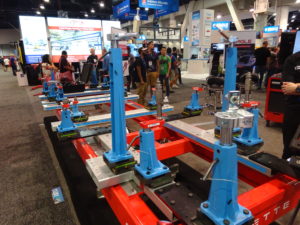
Nissan position: Measure vehicles before, after structural repairs
By onAnnouncements | Repair Operations | Technology
Nissan last month directed auto body shops to measure a vehicle before and after a structural repair, a critical element of collision work one expert has noted repairers might be neglecting.
Astech industry relations director Jake Rodenroth noted in August that 30 percent of ostensibly repaired vehicles sent to his company for calibration failed because they weren’t straight enough, he said.
“Nissan vehicles, whether constructed on a framed or unibody platform, require different techniques to correct body alignment issues after a collision, incident, or loss,” Nissan wrote Dec. 12, 2018, in one of nine recent new or updated position statements. “Repairs requiring any structural or alignment corrections are the first step in the restoration process and the basis of a safe and quality repair.
“To ensure that a vehicle is repaired and restored to factory specifications, measurements should be taken both before and after a frame or structural repair. This ensures proper body alignment that could affect safety or mechanical systems.”
Infiniti issued a virtually identical position statement six days later.
Nissan also cautioned shops against relying on any measurements outside of its official data, bringing to mind a 2017 warning from Audi against measurements on unapproved benches.
“Measurements can be found in the Electronic Service Manual (ESM) taken from a variety of control points during production,” Nissan wrote. “Nissan North America has not validated any alternative measurements provided by a third party vendor and refers all collision repair professionals to the ESM measurements. … Initial damage measurements will also be helpful in repair-versus-replace scenarios.
“… Proper anchoring techniques should be used during body alignments and may vary depending on the alignment system being used. Recommended anchoring techniques can also be found in the Electronic Service Manual (ESM) for each model. Corrective push/pull methods will be outlined there as well and should be used in conjunction with machine manufacturer’s guidelines.”
Nissan also reminded shops that the measurement process could add extra R&Rs or R&Is.
“Removal of vehicle components, panels, or exterior trim may be necessary to perform accurate measuring during the repair process,” Nissan wrote. “… Any protective coating (seam sealer, stone guard, undercoating, corrosion protection, etc.) removed for initial setup or damaged in the repair process should be restored accordingly.”
Estimators and technicians are going to want to consider these factors — some of which might be not-included operations — when developing a repair plan and delivery date.
More information:
“POSITION STATEMENT: Frame and Unibody Pulling”
Nissan, Dec. 12, 2018
“POSITION STATEMENT: Frame and Unibody Pulling”
Infiniti, Dec. 18, 2018
Nissan collision repair procedures website (use Internet Explorer)
Infiniti collision repair procedures website (use Internet Explorer)
Featured image: A Celette Rhone L bench is shown at SEMA 2018. (John Huetter/Repairer Driven News)
